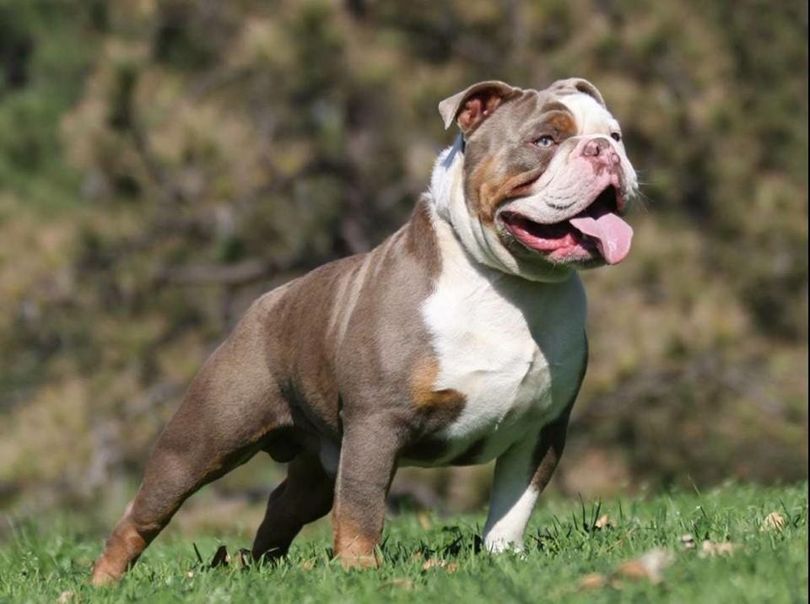Dog Breed
Olde English Bulldogge
Guard Dog

- Full Name
- Olde English Bulldogge
- Your PupScore
- Take the best dog breed quiz to get your Pup Scores!
- Life Span
- 9 – 14 years
- Weight
- 65 – 85 pounds
- Description
The Olde English Bulldogge is unique that it is actually not a British dog breed, but from the United States. It is a fairly new breed of dog, and was developed with the purpose to recreated the original English Bulldog of the past, which was more agile, and even more healthy than the modern bulldog in a lot of ways. The Olde English Bulldogge should be strong, agile, and a good guard dog, but very friendly with family, and quick to accept new people and dogs that they meet.
- Origin
- United States of America
- Family Considerations
- Overall Ease of Breed
- Personality
- Home and Environment Considerations
- Physical Characteristics
Child Friendly
4/5
Is the Olde English Bulldogge good with children?
Yes, the Olde English Bulldogge is very friendly with children. We still recommend introductions to children while they are young so they get used to them, but the Olde English Bulldogge naturally loves children.
Stranger Friendly
2/5
Is the Olde English Bulldogge friendly with strangers?
The Olde English Bulldogge is not automatically friendly with strangers and we would not recommend for a living situation with frequent guests.
Dog Friendly
2/5
Is the Olde English Bulldogge friendly with other dogs?
The Olde English Bulldogge is not naturally friendly with other dogs, but with a good amount of early socialization as a puppy they can learn to get along with most breeds of dog. Proper training is required before letting the Olde English Bulldogge go off-leash or to dog parks.
Likes to Cuddle
4/5
Does the Olde English Bulldogge like to cuddle?
The Olde English Bulldogge appreciates affection and that includes kisses and snuggles!
Playfulness
4/5
Does the Olde English Bulldogge like to play?
The Olde English Bulldogge will almost always be ready for play! The Olde English Bulldogge is great for a family with children, or otherwise, an environment that is always ready for play.
Service Dog Ability
3/5
Does the Olde English Bulldogge make a good service dog?
The Olde English Bulldogge is not typically used as a service dog. There are always exceptions to the rule, but a service dog has to have many natural traits in addition to the proper training- smart, patient, and obsessed with pleasing their owner.
Ease for Novice
2/5
Is the Olde English Bulldogge good for first-time owners?
The Olde English Bulldogge would not be the best fit for first-time owners. A breed is only good for first-time owners if it is raised for home companionship, and is open to training and is motivated to please its owner.
Training Potential
3/5
How well can the Olde English Bulldogge be trained?
The Olde English Bulldogge is about average when it comes to training potential. The Olde English Bulldogge can be seen in competitions and can have advanced training, but it would require much dedication and oftentimes professional training.
Amount of Shedding
1/5
Does the Olde English Bulldogge shed a lot?
No! The Olde English Bulldogge does not shed very much, and can be an excellent fit for someone who suffers from dog allergies.
Ease of Grooming
4/5
Is the Olde English Bulldogge easy to groom?
The Olde English Bulldogge requires some grooming, but less than the average dog breed. Typically you will not need to take the Olde English Bulldogge to the pet salon, and occasional combing at home should be enough.
Exercise Need
3/5
Does the Olde English Bulldogge need a lot of exercise?
The Olde English Bulldogge requires an average amount of exercise. You should be ready to dedicate a couple of short walks or a larger dog park session each day for your Olde English Bulldogge to be happy and fulfilled.
Intelligence
2/5
How smart is the Olde English Bulldogge?
The Olde English Bulldogge is a bit goofy and may not be as intelligent as some other breeds, but that is what people oftentimes love about the Olde English Bulldogge!
Amount of Barking
2/5
How much does the Olde English Bulldogge bark? Does the Olde English Bulldogge bark too much?
The Olde English Bulldogge occasionally barks, but only for specific reasons such as when they need something, for protection, etc.
Guard Dog Ability
5/5
Is the Olde English Bulldogge a good guard dog?
The Olde English Bulldogge can serve as an excellent guard dog. It is both physically intimidating and also enjoys having a "job" to protect its family and property.
Tolerates Being Alone
3/5
Is the Olde English Bulldogge good at staying alone? Is the Olde English Bulldogge independent?
The Olde English Bulldogge does not enjoy being left alone for extended periods. They can do well for a couple of hours alone, but may have anxiety for time beyond that.
Good for Apartment Living
2/5
Is the Olde English Bulldogge a good apartment dog?
The Olde English Bulldogge is not a good dog for apartment living for several reasons. It is still possible to make it work if the owner is dedicated to plenty of training and daily exercise, but it may be challenging.
Size
5/5
How big is the Olde English Bulldogge?
The Olde English Bulldogge is one of the biggest dog breeds in the world. In the "giant" category!
Tolerates Heat
2/5
How much does the Olde English Bulldogge tolerate hot weather? When is it too hot for a Olde English Bulldogge?
The Olde English Bulldogge does not tolerate hot weather very well, and we would not recommend having a Olde English Bulldogge if you live in a very hot weather climate. At the minimum, they would need a home with air conditioning.
Tolerates Cold
4/5
How much does the Olde English Bulldogge tolerate cold weather? When is it too cold for a Olde English Bulldogge?
The Olde English Bulldogge can tolerate cold weather well. Play time in the snow or on particularly cold evenings may need to be limited, but overall they can do well in cold climates.
Potential to Run Away
1/5
Does the Olde English Bulldogge try to run away?
The Olde English Bulldogge is very unlikely to run away. Of course, precautions should always be taken, and every dog is unique, but with a Olde English Bulldogge it is very likely they will naturally follow you, even when they are off-leash.
General Health
2/5
Is the Olde English Bulldogge a healthy dog? The health of a Olde English Bulldogge should be measured not just by how many years they live, but also by how many health issues they've had. It is important to know which health conditions your breed is prone to- hip problems, eye problems, bloating, and arthritis are all common dog health problems.
The Olde English Bulldogge has many health problems that should be considered. The Olde English Bulldogge can still live a perfectly healthy life, but it's important to consider all of these health risks ahead of time.
Energy Level
2/5
How energetic is the Olde English Bulldogge?
The Olde English Bulldogge has some energy and requires daily walks, but overall the Olde English Bulldogge has less energy than average.
Amount of Drooling
5/5
How much does the Olde English Bulldogge drool?
The Olde English Bulldogge is one of the dog breeds that drools the most. It may not be the most important factor, but something to consider if you live in a home where that may bother you.
Prey Drive
1/5
Does the Olde English Bulldogge have a large prey drive? Does the Olde English Bulldogge like to chase birds, cats, and other small animals?
The Olde English Bulldogge does not have a large prey drive towards birds or even cats, and can typically do very well living in the same home as them.
Athleticism
2/5
Is the Olde English Bulldogge atheltic?
The Olde English Bulldogge can have athletic moments, and bursts of speed, but does not have the endurance as other highly athletic dog breeds. They would do great for occasional jogs, but probably not the best for long-distance runs or anything more athletic than that.
 Dog
Dog- Non-Sporting
- Mastiff
- Olde English Bulldogge
The Olde English Bulldogge is a purebred dog that belongs to the Mastiff sub group, which falls under the larger Non-Sporting dog breed group.
Non-Sporting group: The Non-Sporting group of dogs is probably the most diverse in the sense that it has a variety of dogs, and they were not all bred for one specific purpose. Each breed in the non-sporting group is unique!
They have been primarily bred as house pets, and because of that make excellent additions to the family. Exercise is still important for them, but the typical non-sporting dog does not have the energy of of a sporting or working group dog.
Mastiff sub-group: Masttiff breeds are the world's ancient and giant breed. They are thought to have originated from from Tibet and China, although there is evidence that they have been throughout Europe- the Roman Empire and Greece for thousands of years as well.
They were used as big game hunters and noble guard dogs. Mastiffs are not particularly high endurance or energy, but quiet intense in short bursts, which is perfect for protection and property protection. Through the years the mastiff has become more friendly and suitable for families, and their calm and composed temperament can actually be more suitable for a house (or even apartment) than it may seem.
Olde English Bulldogges for adoption
Similar Breeds



